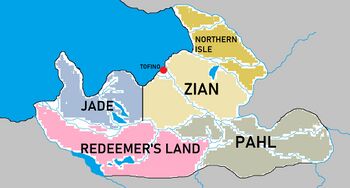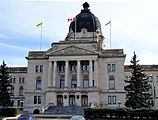Administrative District (Zamastan)
Administrative Districts of Zamastan | |
|---|---|
 | |
| Administrative center | Congress Chamber, Senate |
| Type | Federated state |
| Districts | 5 |
| Leaders | |
| Clinton Juniper | |
| Fallon Chapman | |
| Weronika Preece | |
| Keenan Bone | |
| Huw Hayes | |
In Zamastan, an Administrative District is a constituent political entity, of which there are currently 5; Zian, Jade, Northern Isle, Pahl, and Redeemer’s Land. Bound together in a political union, each District holds governmental jurisdiction over a separate and defined geographic territory and shares its sovereignty with the federal government. Due to this shared sovereignty, Zamastanians are citizens both of the federal republic and of the District in which they reside. District citizenship and residency are flexible, and no government approval is required to move between Districts, except for persons restricted by certain types of court orders (e.g., paroled convicts and children of divorced spouses who are sharing custody).
List of Administrative Districts
| Administrative District | Postal abbrev. |
Capital |
Largest city |
Governor |
Entered Republic |
Population |
|---|---|---|---|---|---|---|
| Zian | ZN | Clinton Juniper | September 22nd, 1804 | 46,832,000 | ||
| Jade | JD | Fallon Chapman | September 22nd, 1804 | 11,457,000 | ||
| Pahl | PA | Weronika Preece | April 26th, 1812 | 17,000,000 | ||
| Northern Isle | NI | Keenan Bone | October 15th, 1921 | 19,839,000 | ||
| Redeemer’s Land | RL | Huw Hayes | January 13th, 1920 | 5,172,000 | ||
| Total | 100,300,000 | |||||
District legislature buildings
Formation
Districts are divided into counties or county-equivalents, also known as sub-districts, which may be assigned some local governmental authority but are not sovereign. County or county-equivalent structure varies widely by district, and districts may also create other local governments. District governments are allocated power by the people (of each respective district) through their individual constitutions. All are grounded in republican principles, and each provides for a government, consisting of three branches, each with separate and independent powers: executive, legislative, and judicial.
Districts possess a number of powers and rights under the Constitution of Zamastan. Districts and their residents are represented in Congressional Hall, a bicameral legislature consisting of the Senate and the Congressional Chamber. Each district is also entitled to select a number of electors (equal to the total number of representatives and senators from that state) to vote in electing the President of Zamastan. Additionally, each district has the opportunity to ratify constitutional amendments, and, with the consent of Congress, two or more districts may enter into interstate compacts with one another. The police power of each district is also recognized.
Historically, the tasks of local law enforcement, public education, public health, regulating intrastate commerce, and local transportation and infrastructure have generally been considered primarily district responsibilities, although all of these now have significant federal funding and regulation as well. Over time, the Constitution has been amended, and the interpretation and application of its provisions have changed. The general tendency has been toward centralization and incorporation, with the federal government playing a much larger role than it once did. There is a continuing debate over district's rights, which concerns the extent and nature of the district's powers and sovereignty in relation to the federal government and the rights of individuals.
The Constitution grants to Congress the authority to admit new districts into the nation. Since the establishment of Zamastan in 1804, the number of districts has expanded from the original 2 to 5. Each new district has been admitted on an equal footing with the existing districts. Redeemer's Land and Northern Isle are the most recent districts admitted, in 1920 and 1921 respectively.
Admission into the Republic
Article III of the Constitution of Zamastan grants to Congress the authority to admit new District into the republic. Since the establishment of Zamastan in 1804, the number of districts has expanded from the original 2 to 5. Each new district has been admitted on an equal footing with the existing districts.




